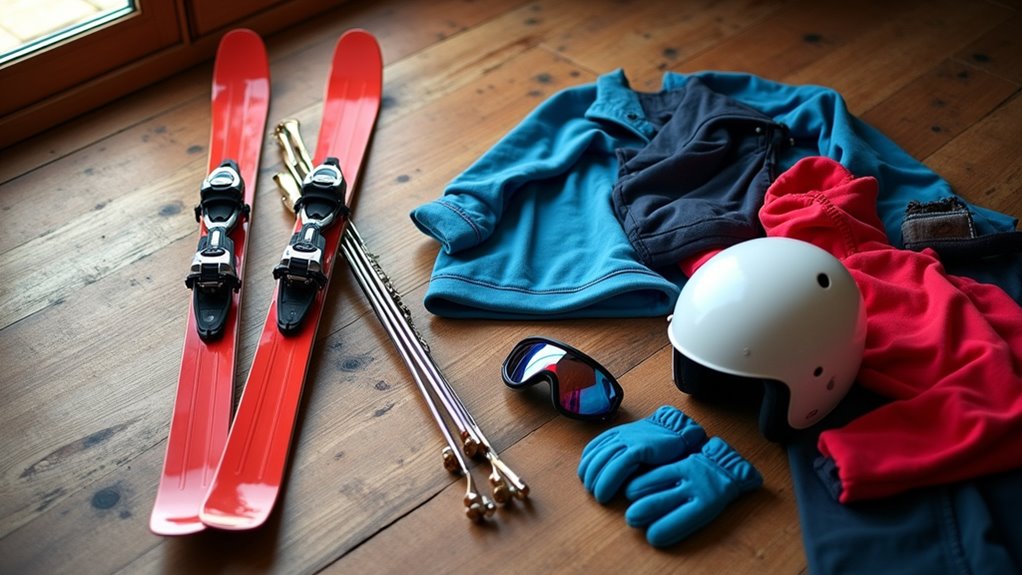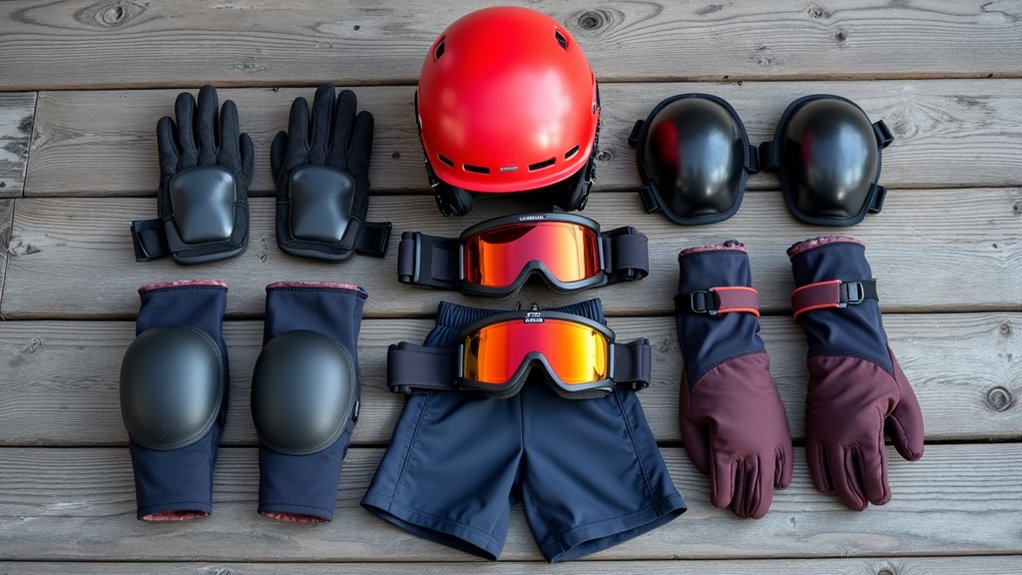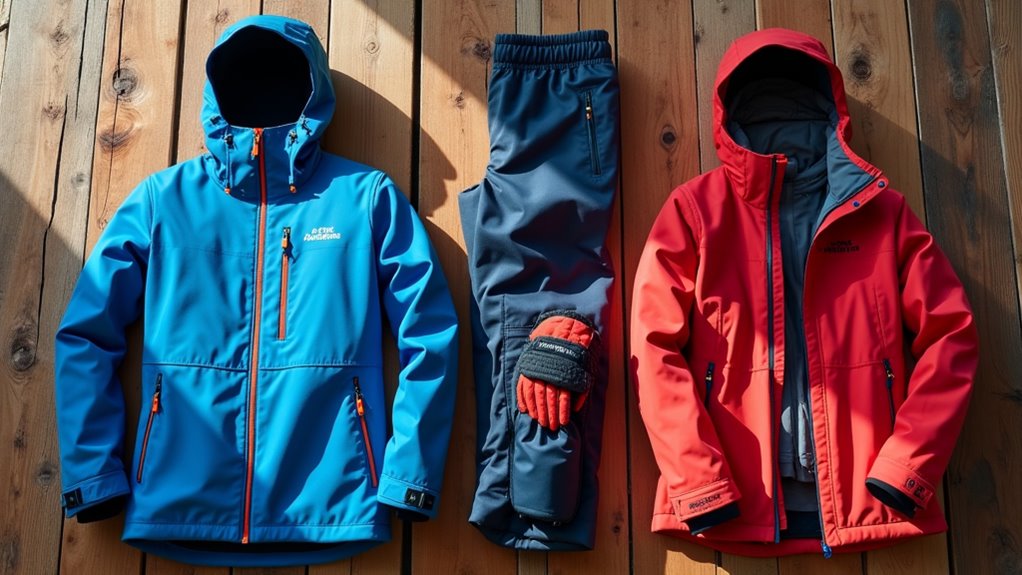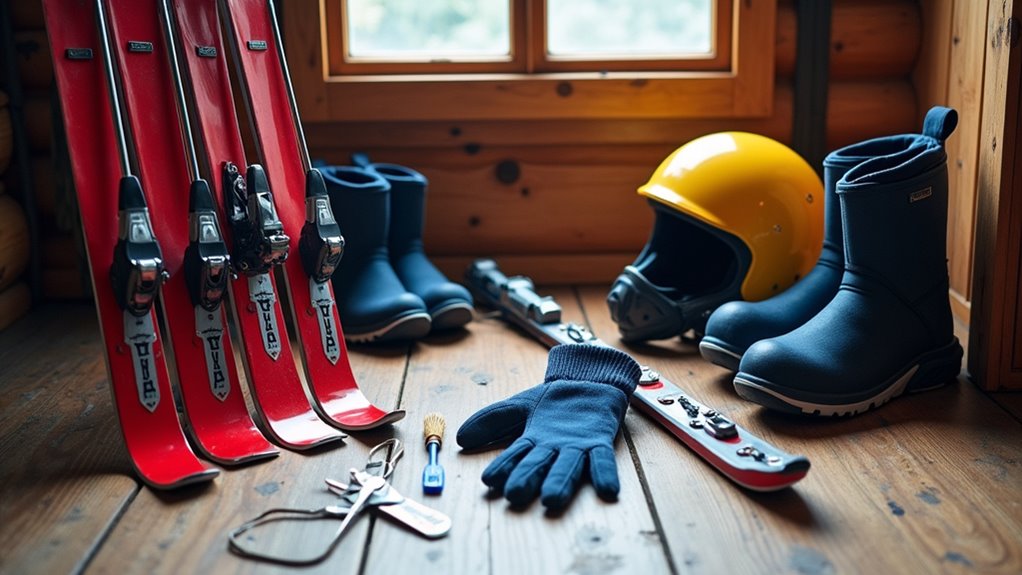Physical Address
304 North Cardinal St.
Dorchester Center, MA 02124
Physical Address
304 North Cardinal St.
Dorchester Center, MA 02124

Aspiring skiers can master the slopes with confidence by choosing the right equipment, but what gear do you actually need?
Like assembling a puzzle, getting your first ski equipment setup requires careful attention to each piece. You’ll need to make strategic choices about gear that’ll keep you safe and comfortable without draining your bank account. Whether you’re planning to hit the bunny slopes or dreaming of tackling intermediate runs, your equipment choices will make or break your skiing experience. Let’s explore what you’ll actually need and where you can save money without compromising safety.

When hitting the slopes, your safety gear can mean the difference between an exhilarating day of skiing and a trip to the emergency room. Start with a well-fitted helmet to protect against head injuries, and pair it with goggles that shield your eyes from UV rays and flying snow. Experts recommend replacing helmets every 3 to 5 years to maintain optimal protection.
Don’t forget a face mask or balaclava to guard against biting winds. Your body needs protection too. Invest in back protection, knee pads, and wrist guards to minimize injury risk during falls.
If you’re planning to venture into challenging terrain, consider adding a chest protector. While some rental shops include basic safety gear, you should aim to own essential items like gloves and UV-protective eyewear.
How well your ski boots fit can make or break your entire skiing experience. To find your correct size, measure your foot length in centimeters (Mondopoint system) by standing against a wall on paper. Always try on boots in the afternoon when feet tend to be at their largest size during the day.
Proper ski boot sizing is essential for an enjoyable day on the slopes. Start by measuring your feet using the Mondopoint system.
You’ll need to match the boot’s last width (97mm-106mm) to your foot width for ideal comfort.
If you’re a beginner or intermediate skier, opt for a Standard Fit with softer flexibility for more comfort while learning.
Advanced skiers should consider a Performance Fit with stiffer boots for better control.
Don’t skip visiting a professional boot fitter – they’ll help you navigate brand variations and customization options like molded liners and stance adjustments.

Ski bindings serve as the critical connection between your boots and skis, playing an essential role in both performance and safety.
You’ll want to find several types to match your skiing style: alpine bindings for downhill resort skiing, touring bindings for backcountry adventures, and specialized options for Nordic and telemark skiing.
When selecting bindings, make certain they’re compatible with your boot type and size. Alpine bindings feature toe and heel pieces with DIN certification, which standardizes release values based on your weight, height, and ability level. The anti-friction devices help ensure smooth boot release during falls.
You’ll want to get them professionally mounted and adjusted annually for safety.
Entry-level bindings are more affordable and focus on ease of use, while advanced models offer enhanced performance features.
Consider integrated binding systems if you’re looking for easy adjustability and quick swap options.
Proper clothing layers form the foundation of a comfortable day on the slopes.
A well-planned layering system isn’t just about staying warm – it’s the key to an enjoyable skiing experience.
You’ll need a snug-fitting base layer made of merino wool or synthetic materials to wick away moisture from your skin. Don’t skimp on quality here – it’s essential for preventing hypothermia. The three primary layers system is proven to be most effective for skiing.
For your mid-layer, opt for fleece or down insulation. You won’t need more than two mid-layers, so choose versatile pieces that you can easily remove if you get too warm.
Look for budget-friendly fleece options that offer good warmth-to-weight ratio and packability.
Remember to protect your extremities with moisture-wicking socks, warm gloves, and a hat. A neck gaiter is also worth the investment.
When shopping, focus on pieces that can serve multiple purposes – many quality base and mid-layers work well for other outdoor activities too.

When selecting outerwear for skiing, your jacket serves as the vital defense against harsh mountain conditions.
You’ll need to choose between three main types: shell jackets for versatile layering, insulated jackets for built-in warmth, or 3-in-1 designs that offer both options. Resort skiers benefit most from jackets made with thicker fabrics around 100D or higher.
Look for essential features like a powder skirt to keep snow out, helmet-compatible hood, and pit zips for temperature control.
Materials matter – Gore-Tex and similar waterproof membranes offer the best protection, while DWR coatings help shed moisture.
Don’t skip checking the seam sealing and adjustable cuffs.
While budget-friendly options exist, investing in a higher-quality jacket often pays off.
You’ll get better durability, more reliable waterproofing, and improved breathability – vital features if you’re planning to ski regularly.
Beyond quality outerwear, your skiing experience hinges on having the right accessories for comfort, safety, and enjoyment on the slopes.
Start with essential safety gear: a well-fitted helmet like the Smith Vantage, goggles for visibility, and a protective face mask. Don’t forget a basic first aid kit and ski lock to secure your equipment. High-altitude exposure requires UV-protective lip balm.
For comfort, invest in quality wool ski socks and waterproof gloves. A neck gaiter and helmet liner will keep you warm without bulk.
Consider a smartwatch to track your performance and a small backpack to carry water and snacks. If you’re planning multiple trips, grab a proper ski bag for travel.
Remember to maintain your gear with basic tuning tools and wax – it’ll save you money on shop services and extend your equipment’s life.

Successful skiing adventures start with smart weather preparation and consistent gear maintenance.
Before hitting the slopes, check local weather reports and pack layers accordingly – you’ll need a moisture-wicking base, insulating mid-layer, and waterproof shell. Don’t forget UV protection for your skin and eyes.
Layer up smart with moisture-wicking base, insulating mid, and waterproof shell. Local weather checks and UV protection are non-negotiable.
Keep your gear in top shape by inspecting skis, bindings, and boots before each outing. Store boots with liners removed for thorough drying after use. Sharpen edges every 10 days of use and wax skis after 3-4 trips.
You’ll need basic maintenance tools like a metal file, P-Tex candle, and waxing iron. For deep scratches or binding issues, seek professional repairs – it’s cheaper than replacing damaged equipment.
Monitor snow conditions daily and adjust your equipment accordingly. Use cold wax for freezing temperatures and wider skis for powder days.
Store your gear properly indoors to prevent damage.
Smart gear maintenance pairs naturally with proper safety equipment on the slopes.
You’ll need to prioritize essential protective gear before hitting the mountain, focusing on items that offer maximum safety without breaking the bank. With only 3.9 injuries per 1000 visitor days, skiing remains a relatively safe sport when proper equipment is used. Consider renting specialized equipment until you’re committed to the sport.
Essential safety gear for every ski trip:
Remember to pack a basic first aid kit in your ski backpack, and don’t forget your waterproof, insulated outerwear.
While some items might seem optional, investing in core safety equipment will enhance your skiing experience and protect you from common injuries.
Now you’re ready to hit the slopes like a pro without breaking the bank. Take advantage of end-of-season sales for big-ticket items and consider renting equipment for your first few runs. Don’t forget to maintain your gear – it’ll save you money in the long run. With your protective armor in place and confidence soaring, you’ll glide down those snowy peaks like a winter warrior.